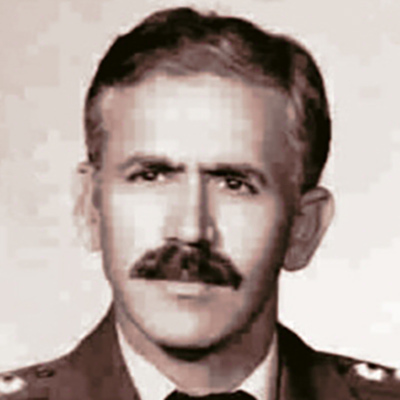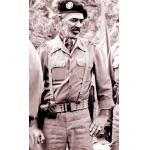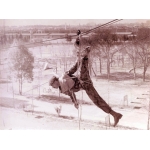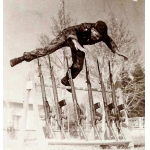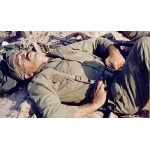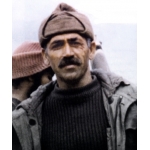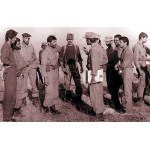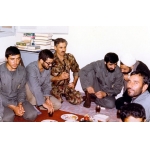People
Abshenasan, Hassan
Fatemeh Ataie
141 دورہ
Hassan Abshenasan was the commander of the 26th NOHED Division of the Islamic Republic of Iran Army. He was martyred on September 30, 1985, in Operation Qader in Sarsul Kelashin area, northern Iraq.
He was born on May 9, 1936, in the Emamzadeh Yahya neighborhood of Naziabad, Tehran.[1] His father, Qorban-Ali, worked for the Ministry of Education, and his mother’s name was Uzra. In 1957, he entered the military university and three years later graduated as Second Lieutenant. He was among the first group to complete the commando training course in 1962. That same year, he married Giti Zendehnam, and they had two sons and a daughter.[2]
In 1964, Abshenasan was promoted to first lieutenant. He first served in the 8th Ahvaz Infantry Division and later became the physical training officer of the 22nd Brigade of that division. In 1968, he was promoted to captain in Dezful and soon commissioned to Shuosh. After taking part in Operation Arvand, which was launched in response to Iraq’s territorial claims over the Arvand River, Abshenasan was reassigned to the Tehran Military Police Battalion. He completed an English language course in 1970 and then went to Fars Province, where he spent about ten years in Shiraz.
Abshenasan undertook advanced infantry warfare and Command and Staff (DAFOOS) courses in 1972 and 1975, respectively. The following year, he was promoted to lieutenant colonel and appointed head of the Ranger Committee and commando instructor at the Shiraz Infantry Center. In the meantime, he also received commando training in Iran as well as parachute and ranger training in Scotland, finishing first in the course. Abshenasan and his team won first place in an international mountain commando competition held among elite military units from various countries in Scotland.[3]
In 1977, he completed a search-and-rescue course in Rezaieh (Urmia) and, after being promoted to major, was assigned to the 77th Khorasan Division. He also attended an anti-riot training course in Pakistan.
On February 3, 1979, as public protests intensified and concerns grew over the possibility of the Army turning against the people, Abshenasan tried to step down, but his resignation was not accepted.[4] After the Islamic Revolution, he focused on training the Army, the Islamic Revolutionary Guard Corps (IRGC), and Basij forces. In late-1979, he was transferred back to Tehran. When the anti-revolutionary insurgency broke out in Kurdistan, Abshenasan led a campaign to push the insurgents across the border into Iraq. As a result of these efforts, he was appointed by then–West Front Operations Commander Ali Sayyad Shirazi (who was later martyred) to lead the Northwestern Army Headquarters. Abshenasan remained in Kurdistan until the start of the Iran–Iraq War,[5] after which he was sent to the southern fronts. On September 29, 1980, he began working at the Martyr Chamran Irregular Warfare Headquarters and participated in guerrilla operations in the foothills of Dasht-e Abbas, capturing the first invading Iraqi soldiers.[6] Meanwhile, he trained motorcycle riders from Tehran’s Naziabad neighborhood and formed the “Iron Horse Special Group”, tasked with gathering intelligence on Iraqi troop movements. To gather reliable information, he relied on locally trained individuals fluent in Arabic. Abshenasan and a small team would sneak into Iraqi positions at midnight in Dasht-e Abbas, planting anti-tank and anti-personnel mines.[7] Early in the war, when his injury was mistakenly reported as “martyrdom” among the residents of the Dasht-e Abbas, they gave him the nickname “Shahid-e Sahra (Martyr of the Desert)”.[8]
In 1983, Colonel Ali Sayyad Shirazi (martyred), commander of the Iranian Army Ground Forces, appointed Abshenasan commander of the Hamzeh Seyyed al-Shuhada (as) Headquarters in western Iran. Working alongside Muhammad Boroujerdi (martyred), Nasser Kazemi (martyred), and Mahmoud Kaveh (martyred), he helped organize joint forces of the Army and the IRGC.[9]
In late-1984, Abshenasan became commander of the 23rd NOHED Division[10] and was tasked with setting up the first irregular warfare training course for IRGC forces. Early in 1985, he also took command of the 23rd Airborne Special Division.[11]
On September 30, 1985, while serving as commanders of the 26th NOHED Division, the Hamzeh Headquarters, and 23rd Special Forces Division, Abshenasan was martyred during Operation Qader, which he himself had designed, in Sarsoul Kelashin, northern Iraq.[12] His body was laid to rest in section 26, row 79 of Behesht-e Zahra Cemetery in Tehran.
On December 20, 2020, he was posthumously awarded the Medal of Sacrifice by the Supreme Leader of Iran.[13] Today, a highway in northwest Tehran is named after Hassan Abshenasan, and a statue honoring him stands at Goharbaran Camp in Sari, Mazandaran Province.
[1] Shirzadi, Farzam, Roshan-tar az Abi (Brighter Than Blue), Tehran, Shahed, 1381, p. 30.
[2] Edalatkhah, Fariborz, Zendeginame-ye Shahid Sar Lashkar Hassan Abshenasan (Biography of Martyr Major General Hassan Abshenasan), Tehran, Atashbar, 1396, Pp. 27, 35, 36; Sarhangpour Bozorg Vafi, Ali-Reza, Shir-e Sahra (The Lion of the Desert), Tehran, Markaz-e Asnad-e Enqelab-e Eslami, 1382, p. 9.
[3] Ibid.
[4] Hazratianfam, Mozhgan, Cherik-e Pir- Bar Asas-e Zendegi Shahid Sar Lashkar Hassan Abshenasan (The Old Guerrilla – Based on the Life of Martyr Major General Hassan Abshenasan), Tehran, Soore Sabz, Moassese-ye Farhangi Honari-ye Eqlim-e Hekmat-e Iranian, Pp. 41–46.
[5] Hazratianfam, Mozhgan, Ibid., p. 47; Sit-e Navid Shahed, Arefaneh-haye Shahid Hassan Abshenasan dar Goftogu ba Amir Sartip Ahmad Dadbin (The Mystical Reflections of Martyr Hassan Abshenasan in Conversation with Brigadier General Ahmad Dadbin), https://navideshahed.com/fa/news/
[6] Sarhangpour Bozorg Vafi, Ali-Reza, Ibid., Pp. 9–10.
[7] Shirzadi, Farzam, Ibid., p. 33.
[8] Sarhangpour Bozorg Vafi, Ali-Reza, Ibid., p. 10.
[9] Nuraei, Abolfazl, Mardan-e Dasht-e Nour (Men of the Nour Plain), Tehran, Sazman-e Aqidati Siyasi Artesh, 1385, Pp. 36–37; Sahifeh Emam, Vol. 17, Tehran, Moassese-ye Tanzim va Nashr-e Asar-e Emam Khomeini (ra), p. 94.
[10] Edalatkhah, Fariborz, Ibid., p. 57.
[11] Hazratianfam, Mozhgan, Ibid., Pp. 70–71.
[12] Edalatkhah, Fariborz, Ibid., p. 66.
[13] Paygah-e Ettela-resani-ye Artesh-e Jomhuri-ye Eslami-ye Iran (Islamic Republic of Iran Army Website), /AJA.IR




